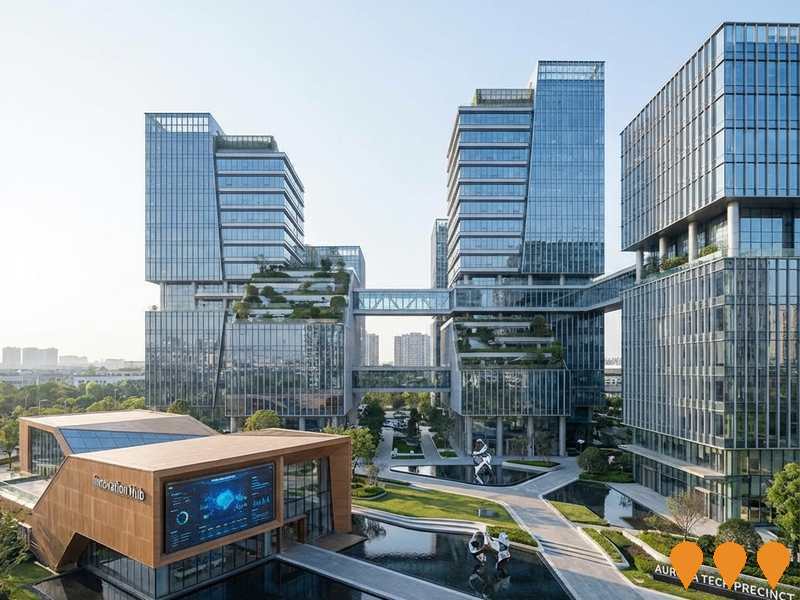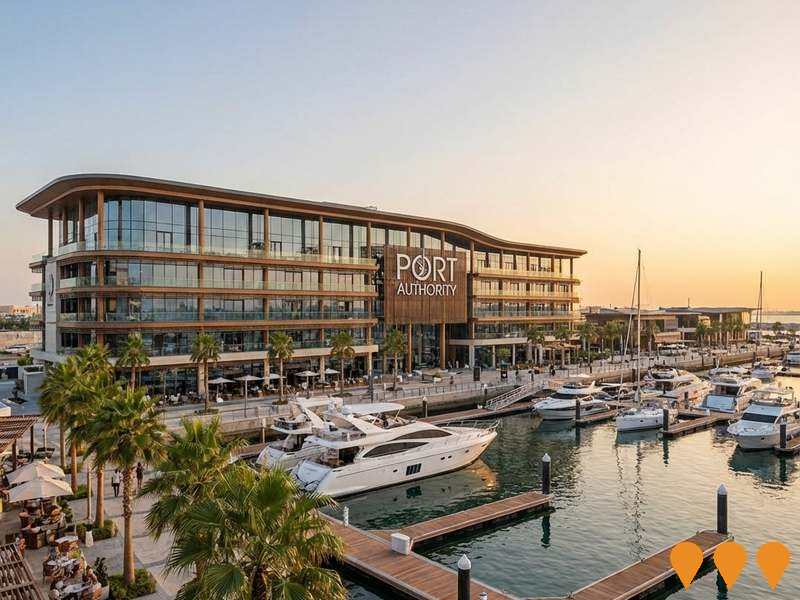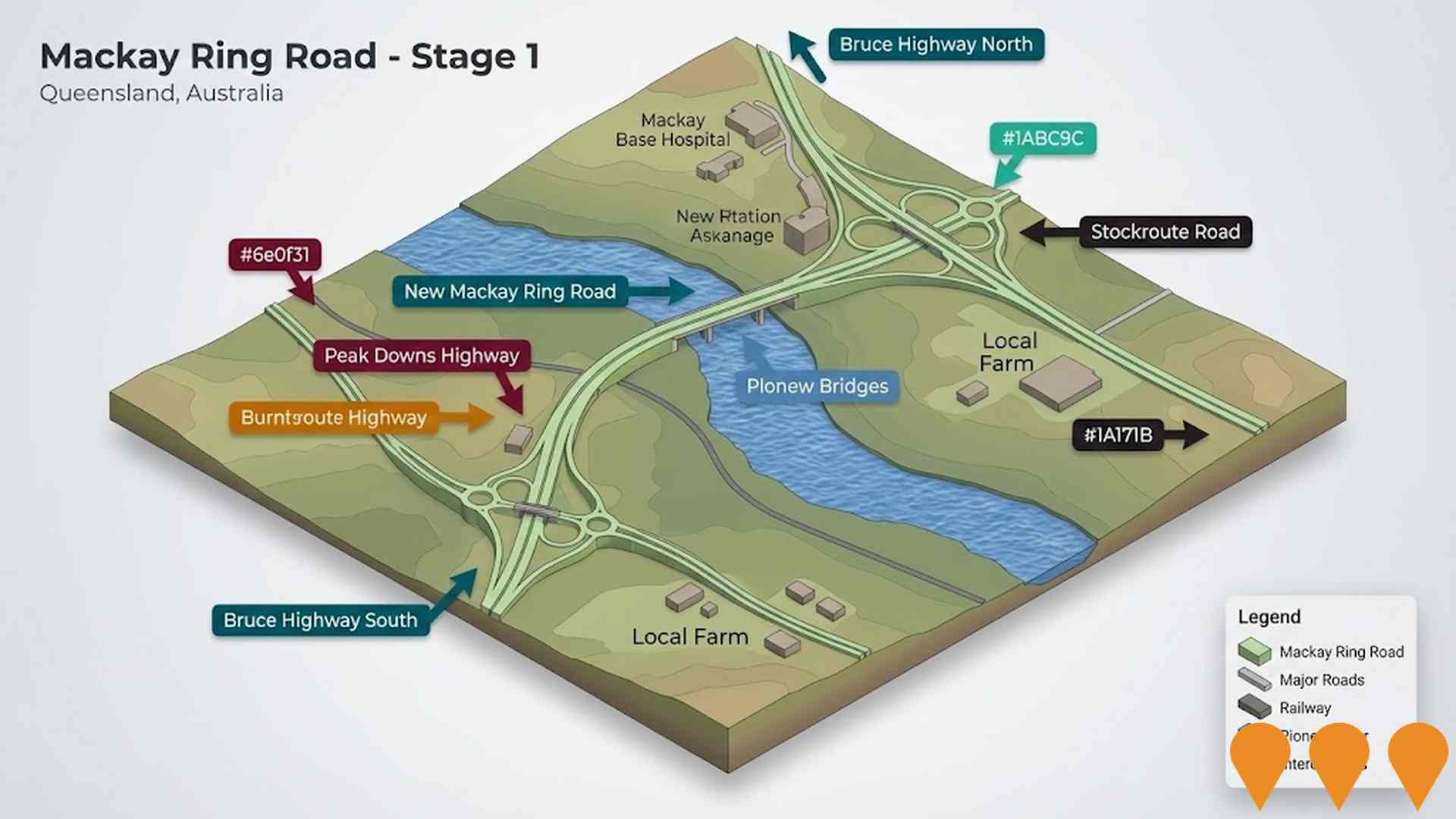Chart Color Schemes
est. as @ -- *
ABS ERP | -- people | --
2021 Census | -- people
Sales Activity
Curious about local property values? Filter the chart to assess the volume and appreciation (including resales) trends and regional comparisons, or scroll to the map below view this information at an individual property level.
Find a Recent Sale
Sales Detail
Population
An assessment of population growth drivers in East Mackay reveals an overall ranking slightly below national averages considering recent, and medium term trends
As of Aug 2025, East Mackay's population is approximately 3,864, reflecting a growth of 108 people since the 2021 Census which reported a population of 3,756. This increase, representing a 2.9% change, is inferred from ABS estimates and validated new addresses between June 2024 and the Census date. The population density ratio stands at 836 persons per square kilometer, aligning with averages observed across similar locations assessed by AreaSearch. Overseas migration contributed approximately 63.8% of overall population gains during recent periods in East Mackay. AreaSearch adopts ABS/Geoscience Australia projections for each SA2 area, released in 2024 using a base year of 2022.
For areas not covered by this data and years post-2032, Queensland State Government's SA2 area projections are used, released in 2023 with a base year of 2021. However, these state projections lack age category splits, so AreaSearch applies proportional growth weightings based on ABS Greater Capital Region projections released in 2023 using data from 2022. Considering projected demographic shifts, East Mackay is expected to experience population growth just below the median of Australian non-metropolitan areas by 2041. Based on the latest population numbers, the area is projected to increase by 272 persons between Aug 2025 and 2041, representing a total increase of 7.0% over this 17-year period.
Frequently Asked Questions - Population
Development
AreaSearch analysis of residential development drivers sees East Mackay recording a relatively average level of approval activity when compared to local markets analysed countrywide
East Mackay has granted approximately 8 residential approvals per year over the past five financial years, totalling 42 homes. As of FY-26, 1 approval has been recorded. On average, around 4.1 people have moved to the area annually for each dwelling built between FY-21 and FY-25. This demand significantly outpaces supply, which typically drives up prices and intensifies competition among buyers.
New homes are being constructed at an average expected cost of $352,000, below the regional average, suggesting more affordable housing options. This financial year has seen $9.5 million in commercial approvals registered, indicating moderate levels of commercial development. Compared to the rest of Queensland and nationally, East Mackay records about 60% of building activity per person, placing it among the 56th percentile of areas assessed. However, recent periods have shown an increase in development activity. New developments consist of 38.0% detached houses and 62.0% medium to high-density housing, marking a shift from the area's existing housing stock, which is currently 73.0% houses. This trend reflects decreasing availability of developable sites and changing lifestyles requiring more diverse, affordable housing options.
East Mackay has an estimated 558 people per dwelling approval, indicating its quiet development environment. By 2041, the area is projected to grow by 272 residents. Building activity is keeping pace with growth projections, but buyers may face increased competition as the population grows.
Frequently Asked Questions - Development
Infrastructure
East Mackay has emerging levels of nearby infrastructure activity, ranking in the 34thth percentile nationally
Changes to local infrastructure significantly impact an area's performance. AreaSearch has identified nine projects likely influencing the region. Key projects include Mackay Base Hospital Expansion, Mackay State Development Area, Mackay Waterfront Priority Development Area, and Great Barrier Reef Arena Redevelopment. The following list details those most relevant.
Professional plan users can use the search below to filter and access additional projects.
INFRASTRUCTURE SEARCH
 Denotes AI-based impression for illustrative purposes only, not to be taken as definitive under any circumstances. Please follow links and conduct other investigations from the project's source for actual imagery. Developers and project owners wishing us to use original imagery please Contact Us and we will do so.
Denotes AI-based impression for illustrative purposes only, not to be taken as definitive under any circumstances. Please follow links and conduct other investigations from the project's source for actual imagery. Developers and project owners wishing us to use original imagery please Contact Us and we will do so.
Frequently Asked Questions - Infrastructure
Mackay Base Hospital Expansion
Major expansion of Mackay Base Hospital to deliver 128 additional inpatient beds, new birthing suites, maternity ward, special care nursery, child and adolescent unit, medical wards, a new multi-storey car park with rooftop helipad, and a new clinical services building. BESIX Watpac is the managing contractor. Construction is underway on early works and the car park; main hospital wing construction progressing. Latest Queensland Health updates confirm revised completion target of 2028 with total project cost approximately $520 million.
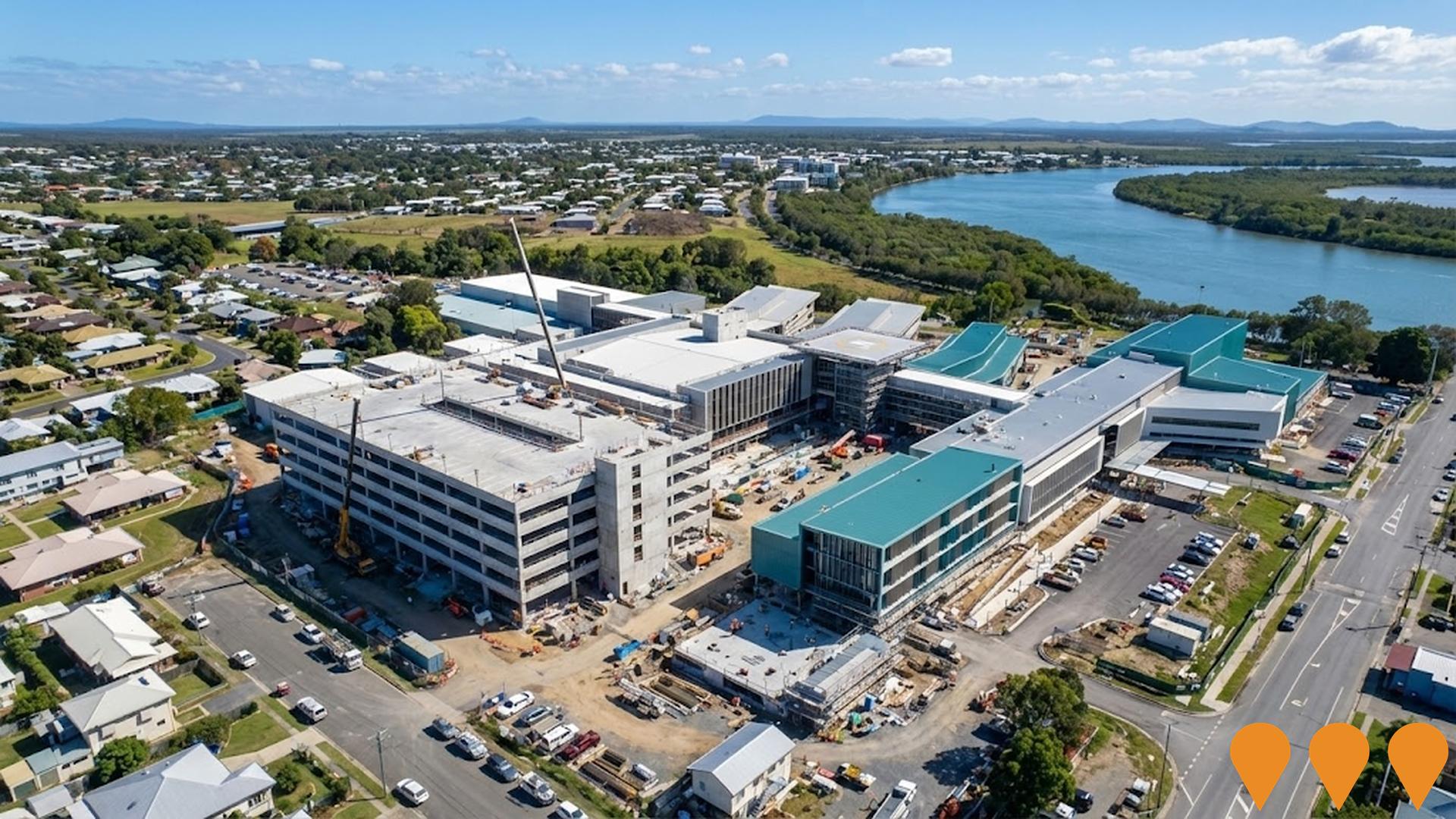
Ooralea Local Plan
A strategic local plan prepared by Mackay Regional Council to guide urban development in the Ooralea area. Key features include a proposed mixed-use Major Centre, Specialised Centre (Homemaker Centre), interconnected walkable neighborhoods, open spaces, integration with surrounding infrastructure like Central Queensland University, and a simple, functional road network. The plan informed the Mackay Region Planning Scheme 2017.
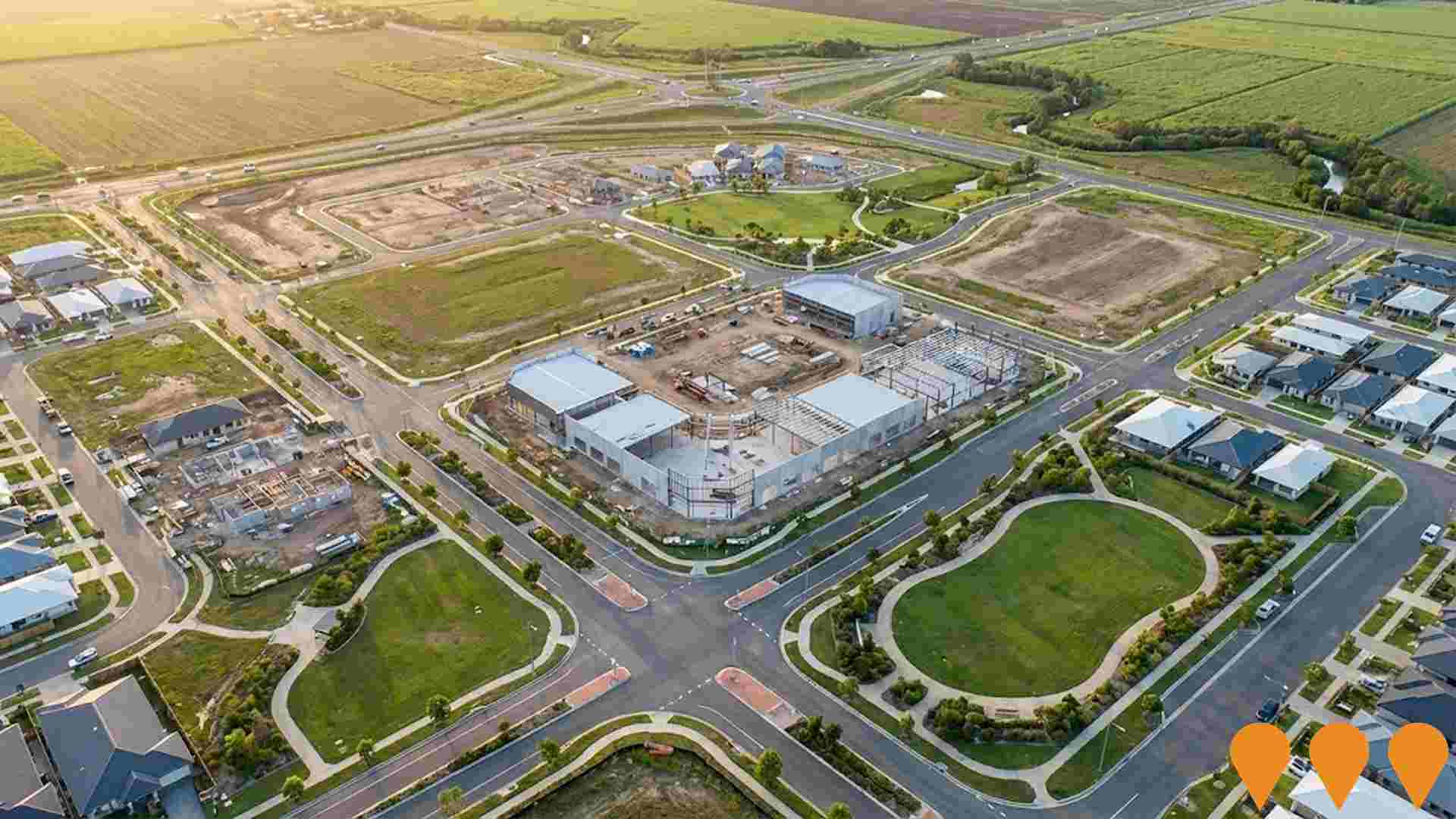
Northern Beaches Community Hub
The Northern Beaches Community Hub is a multi-stage community facility in Mackay's fastest-growing northern suburbs. Stage 1A, opened in July 2025, features an undercover multi-purpose court for basketball, netball, futsal, and pickleball, a 29m crocodile-shaped amphitheatre, nature play area with climbing nets, swings, slide, balance beam, picnic spaces, landscaping, and parking. Stage 1B, under construction since July 2025 and expected to complete by December 2026, includes a modern library, flexible community rooms, town square for events, cafe space, undercover car park, and a Changing Places facility. The hub serves a population projected to grow to over 32,000 by 2041, providing a welcoming meeting place for community activities, programs, and services.

Mackay Waterfront Priority Development Area
The Mackay Waterfront PDA, declared in May 2018, aims to revitalize approximately 172 hectares of land and infrastructure within the Mackay city centre, along the Pioneer River waterfront, through Queens Park, and along the Binnington Esplanade waterfront. This 20-year redevelopment project (2018-2038) seeks to create social, liveability, and economic benefits for the community through mixed-use development including residential, retail, commercial, and tourism facilities. The PDA includes five precincts: Mackay City Centre, Riverside, Enterprise, Queens Park, and Beachside. Recent milestones include the endorsement of the Mackay Waterfront Place Strategy in August 2025 and ongoing public realm improvements. The project aims to reconnect Mackay to the waterfront, create inner-city living options, promote tourism, and improve the region's liveability and investment attraction.
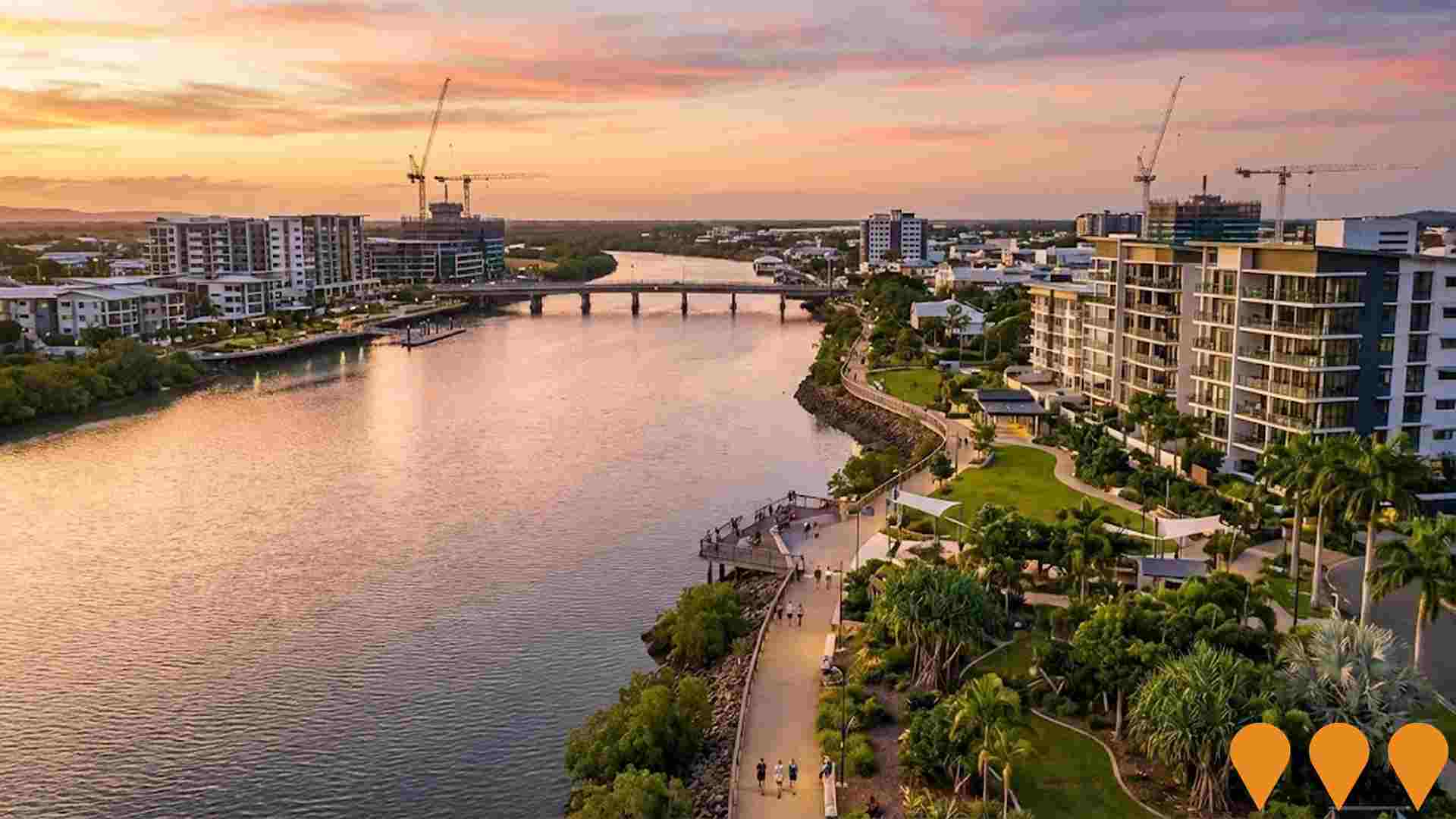
Mackay CBD Revitalization
Comprehensive CBD enhancement including streetscape improvements, public space upgrades, heritage building restoration, and business development initiatives. Focus on creating vibrant urban environment.
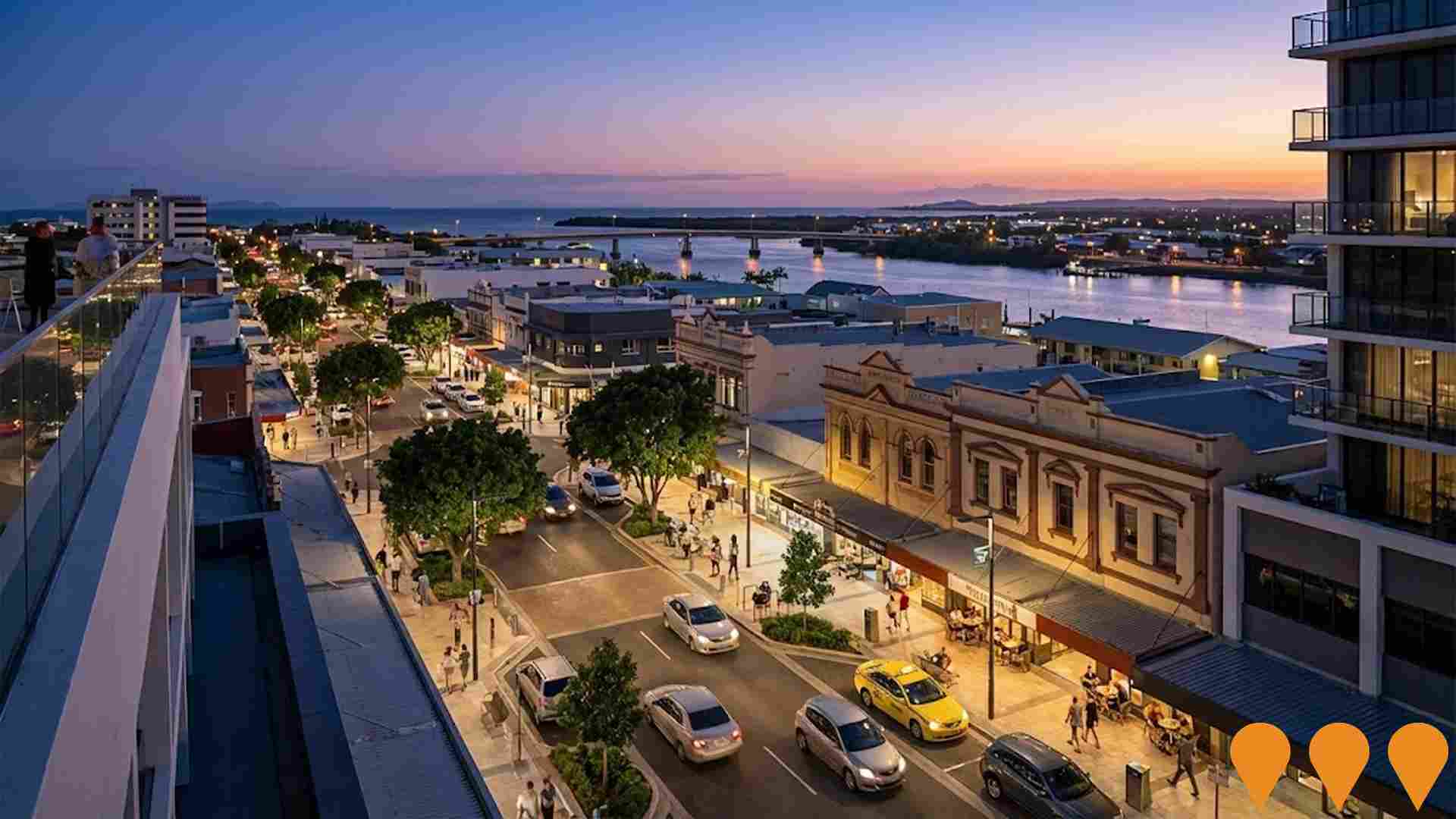
Mackay State Development Area
907 hectares designated for renewable energy and biofutures industries. Supports regional economic diversification and sustainable aviation fuel production. Leverages Mackay's agricultural strengths for net-zero transition industries. Declared February 2024 with development scheme approved September 2024. The SDA incorporates two distinct areas: Racecourse Mill area (137 hectares) approximately 5km west of Mackay CBD, and Rosella area (770 hectares) located 10km south of Mackay CBD. Designed to become Queensland's home for emerging biocommodity industry.
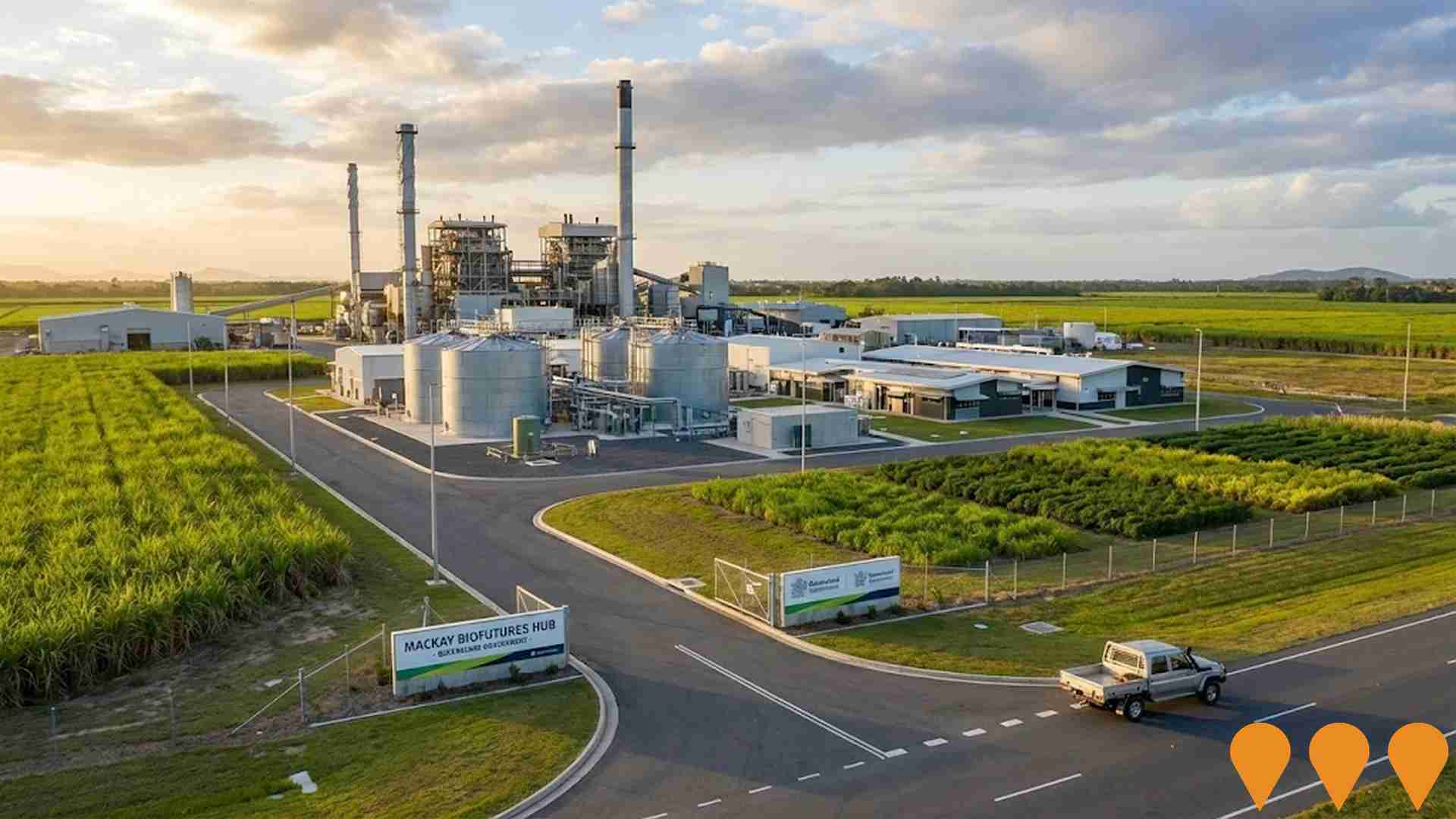
Mackay Port Access Bruce Highway to Mackay Slade Point Road Stage 1
A new 9.5km, 2-lane access road from the Bruce Highway at Glenella to Mackay-Slade Point Road (Harbour Road), to improve access to the Port of Mackay while addressing urban congestion in North Mackay.
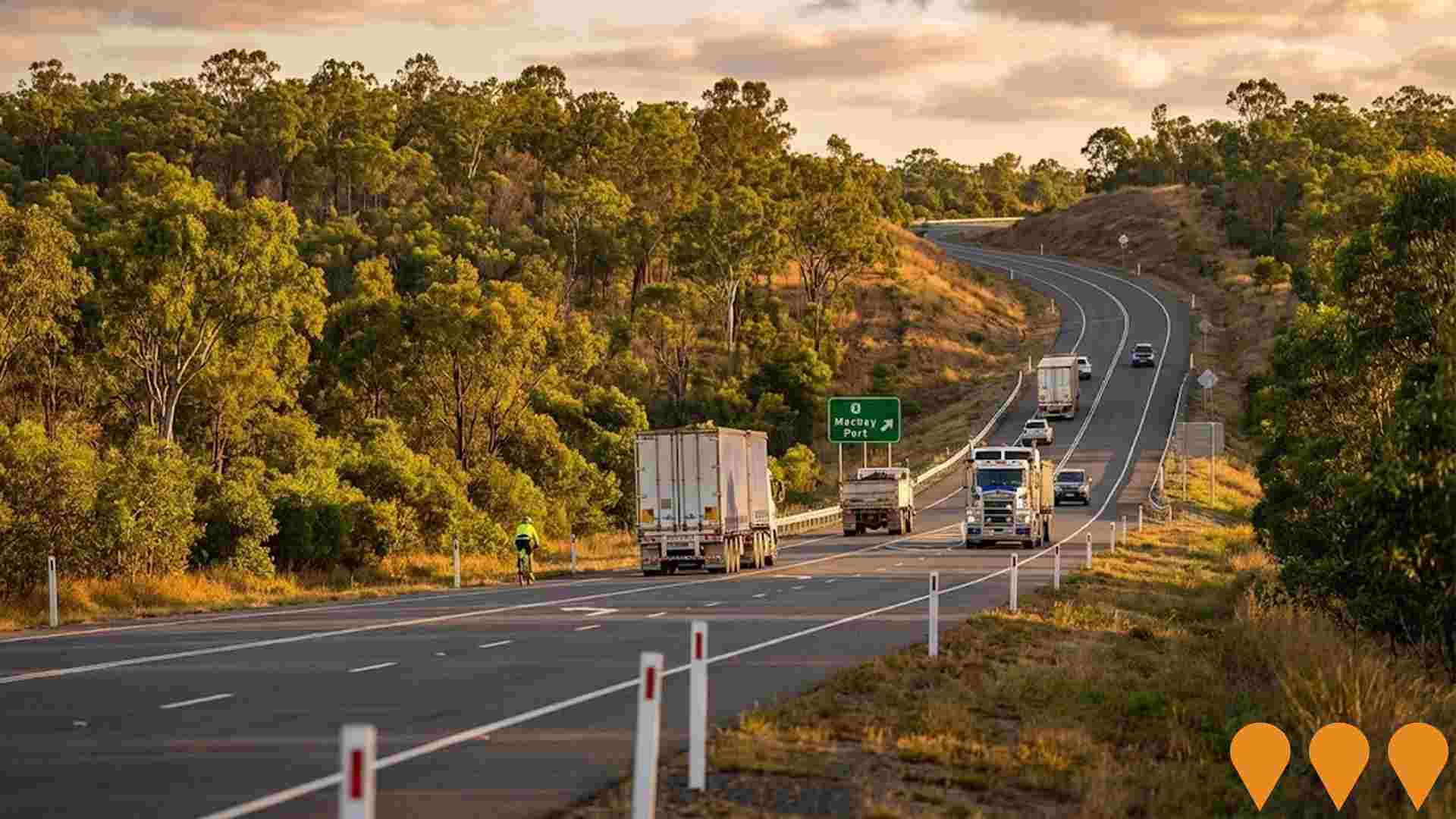
Mercurius Rising Pilot Biorefinery (Mackay)
A pilot biorefinery project to produce renewable diesel and biojet fuel from agricultural and forestry waste (like sugarcane bagasse) using patented REACH technology. The plant has been built, commissioned, and operated at the QUT Renewable Biocommodities Pilot Plant precinct in Mackay. The initial plan for the pilot plant at Gladstone appears to have been superseded by the Mackay facility, which commenced operations in 2021 and was completed with a focus on demonstrating the technology.

Employment
Employment performance in East Mackay ranks among the strongest 15% of areas evaluated nationally
East Mackay has a skilled workforce with strong representation in manufacturing and industrial sectors. Its unemployment rate was 1.8% as of June 2025.
This rate is below the Rest of Qld's rate of 3.9%. Workforce participation in East Mackay is similar to Rest of Qld at 59.1%. Key industries for employment among residents are health care & social assistance, construction, and mining. Mining shows notable concentration with employment levels at 2.5 times the regional average.
Agriculture, forestry & fishing has lower representation at 0.7% compared to the regional average of 4.5%. Employment opportunities locally appear limited based on Census working population vs resident population comparison. Over a 12-month period ending June 2025, employment increased by 1.7% while labour force decreased by 0.3%, leading to a fall in unemployment rate by 1.9 percentage points. In contrast, Rest of Qld saw employment grow by 1.8% and labour force expand by 2.0%, with unemployment rising by 0.2 percentage points. National employment forecasts from Jobs and Skills Australia, issued May 2025, project national employment growth at 6.6% over five years and 13.7% over ten years. Applying these projections to East Mackay's employment mix suggests local growth of approximately 6.3% over five years and 13.3% over ten years.
Frequently Asked Questions - Employment
Income
The area exhibits notably strong income performance, ranking higher than 70% of areas assessed nationally through AreaSearch analysis
AreaSearch aggregated latest postcode level ATO data released for financial year ending June 2022. East Mackay had a median taxpayer income of $63,689 and an average income of $79,635. Nationally, these figures are high, compared to Rest of Qld's $50,780 and $64,844 respectively. Based on Wage Price Index growth from June 2022 to September 2025 (an estimated increase of 13.99%), current estimates for East Mackay would be approximately $72,599 (median) and $90,776 (average). According to the Census conducted in August 2021, personal income ranks at the 70th percentile ($918 weekly), while household income sits at the 48th percentile. Income distribution shows 32.0% of the population falls within the $1,500 - $2,999 range, similar to regional levels (31.7%). After housing costs, 85.7% of income remains for other expenses. East Mackay's SEIFA income ranking places it in the 4th decile.
Frequently Asked Questions - Income
Housing
East Mackay is characterized by a predominantly suburban housing profile, with a higher proportion of rental properties than the broader region
East Mackay's dwelling structures, as per the latest Census, were 72.6% houses and 27.4% other dwellings (semi-detached, apartments, 'other' dwellings), compared to Non-Metro Qld's 85.1% houses and 14.9% other dwellings. Home ownership in East Mackay stood at 29.1%, similar to Non-Metro Qld, with the rest being mortgaged (33.4%) or rented (37.5%). The median monthly mortgage repayment was $1,625, below Non-Metro Qld's average of $1,733. The median weekly rent figure was $320, compared to Non-Metro Qld's $340. Nationally, East Mackay's mortgage repayments were significantly lower than the Australian average of $1,863, while rents were substantially below the national figure of $375.
Frequently Asked Questions - Housing
Household Composition
East Mackay features high concentrations of lone person households and group households, with a lower-than-average median household size
Family households account for 62.6% of all households, including 23.7% couples with children, 27.0% couples without children, and 10.8% single parent families. Non-family households constitute the remaining 37.4%, with lone person households at 32.6% and group households comprising 4.5%. The median household size is 2.3 people, which is smaller than the Rest of Qld average of 2.6.
Frequently Asked Questions - Households
Local Schools & Education
East Mackay faces educational challenges, with performance metrics placing it in the bottom quartile of areas assessed nationally
The area has university qualification rates of 19.5%, significantly lower than the Australian average of 30.4%. This presents both a challenge and an opportunity for targeted educational initiatives. Bachelor degrees are most common at 14.2%, followed by postgraduate qualifications (3.2%) and graduate diplomas (2.1%). Trade and technical skills are prominent, with 41.2% of residents aged 15+ holding vocational credentials - advanced diplomas (9.8%) and certificates (31.4%).
Educational participation is high at 28.4%, including primary education (10.5%), secondary education (9.7%), and tertiary education (3.2%). Victoria Park State School, established in East Mackay on 1st January 1965, serves the local community with an enrollment of 637 students as of 2021. The school focuses exclusively on primary education, with secondary options available in surrounding areas since the late 1980s.
Frequently Asked Questions - Education
Schools Detail
Nearby Services & Amenities
Transport
Transport servicing is low compared to other areas nationally based on assessment of service frequency, route connectivity and accessibility
The analysis of public transport in East Mackay shows that there are currently 15 active transport stops operating. These stops serve a mix of bus routes, with one individual route providing service to all stops. This results in a total of 118 weekly passenger trips across the area.
The accessibility of these transport services is rated as good, with residents typically located just 223 meters from their nearest stop. On average, there are 16 trips per day across all routes, which equates to around seven weekly trips per individual stop.
Frequently Asked Questions - Transport
Transport Stops Detail
Health
Health performance in East Mackay is lower than average with prevalence of common health conditions notable across both younger and older age cohorts
East Mackay faces significant health challenges, with notable prevalence of common health conditions across both younger and older age cohorts. Approximately 59% of its total population (2,295 people) have private health cover, compared to 57.0% across the rest of Queensland.
The most prevalent medical conditions in the area are arthritis and mental health issues, affecting 8.2% and 7.9% of residents respectively. Conversely, 68.3% of residents declared themselves completely clear of medical ailments, compared to 69.7% across the rest of Queensland. East Mackay has a higher proportion of seniors aged 65 and over, with 18.2% (702 people) compared to 16.2% in the rest of Queensland. Health outcomes among seniors present challenges broadly in line with the general population's health profile.
Frequently Asked Questions - Health
Cultural Diversity
East Mackay ranks below the Australian average when compared to other local markets across a number of language and cultural background related metrics
East Mackay had a cultural diversity below average, with 84.2% citizens, 85.0% born in Australia, and 92.4% speaking English only at home. Christianity was the main religion, comprising 56.2% of East Mackay's population, compared to 56.8% in the rest of Queensland. The top three ancestry groups were English (30.3%), Australian (24.2%), and Irish (9.9%).
Notably, Maltese were overrepresented at 1.5%, German was equally represented at 4.7%, and Scottish were slightly overrepresented at 8.8% compared to regional figures of 2.4%, 4.7%, and 7.8% respectively.
Frequently Asked Questions - Diversity
Age
East Mackay hosts an older demographic, ranking in the top quartile nationwide
The median age in East Mackay is 41 years, matching Rest of Qld's average but somewhat older than Australia's average of 38 years. Compared to Rest of Qld, East Mackay has a higher concentration of residents aged 25-34 (14.6%) but fewer residents aged 35-44 (11.0%). According to the 2021 Census, the age group 25-34 grew from 12.6% to 14.6%, while the 15-24 cohort increased from 11.7% to 13.5%. Conversely, the 45-54 cohort declined from 14.3% to 12.3% and the 85+ group dropped from 4.6% to 3.5%. By 2041, demographic projections indicate significant shifts in East Mackay's age structure. Notably, the 25-34 age group is expected to grow by 24%, reaching 701 people from 563 currently. Conversely, the 5-14 and 55-64 cohorts are projected to experience population declines.
